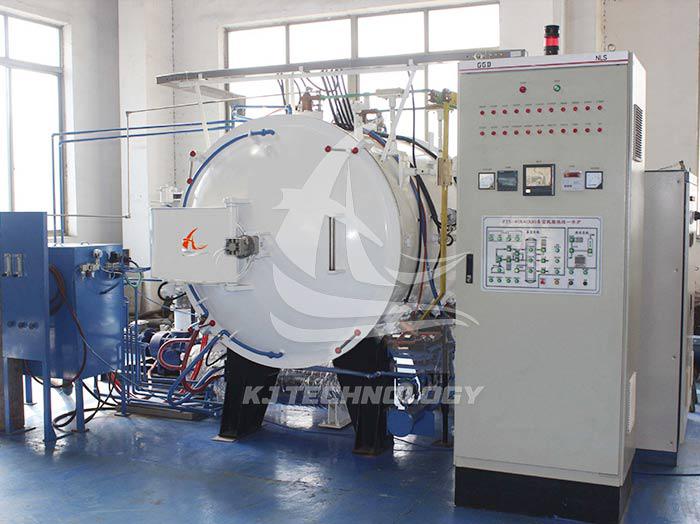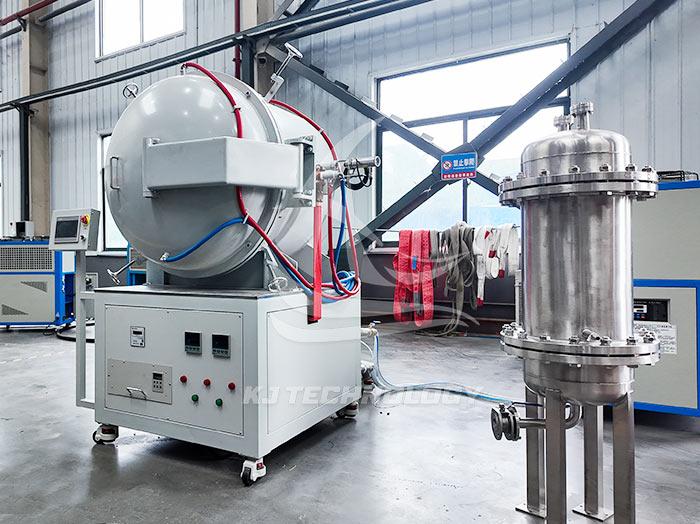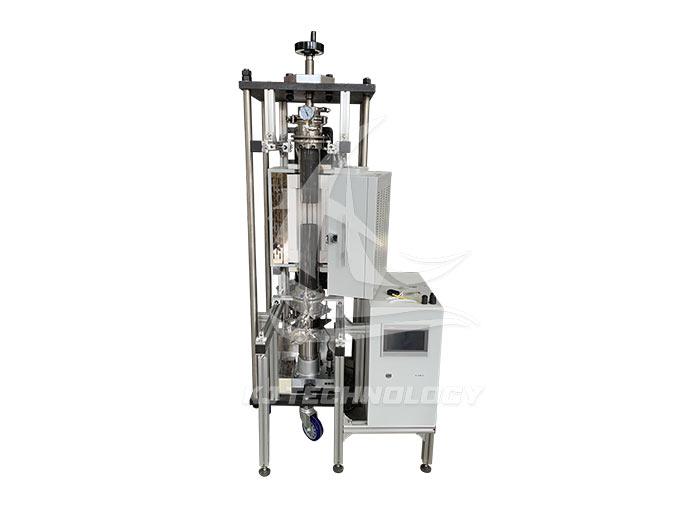Sintering temperature of atmosphere vacuum sintering furnace
 05-29-2025 Author: KJ technology
05-29-2025 Author: KJ technology
Sintering temperature is the core process parameter of atmosphere vacuum sintering furnace, which directly affects the densification, phase transformation, microstructure and final properties of materials. The following analysis is conducted from four aspects: temperature range, influencing factors, control strategies, and typical cases, providing professional guidance for process optimization.
1. Sintering temperature range and typical materials
The sintering temperature needs to be accurately set according to the material characteristics, composition, and performance requirements. The common temperature ranges for materials are as follows:
Typical sintering temperature range of material type Key control points
Hard alloy (WC Co) requires precise control of carbon potential between 1350 ℃ and 1500 ℃ to avoid decarburization or carbonization leading to a decrease in hardness
Ceramics (Al ₂ O ∝, ZrO ₂) require suppression of abnormal grain growth and maintenance of microstructure uniformity at high temperatures ranging from 1500 ℃ to 1750 ℃
Titanium alloy (Ti-6Al-4V) is protected by inert atmosphere (Ar) at 1200 ℃~1300 ℃ to prevent high-temperature oxidation and loss of control of α →β phase transformation
Magnetic material (NdFeB) requires rapid cooling from 1050 ℃ to 1100 ℃ to suppress grain growth and maintain high coercivity
Intermetallic compound (TiAl) 1250 ℃~1350 ℃ vacuum environment to prevent Al volatilization and control phase composition (γ - TiAl/α ₂ - Ti∝ Al)
2. Key factors affecting sintering temperature
Material characteristics
Melting point difference: High melting point materials (such as WC with a melting point of 2870 ℃) require higher sintering temperatures, but overheating should be avoided to prevent abnormal grain growth.
Phase transformation requirement: Some materials need to undergo phase transformation within a specific temperature range (such as the gamma →α ₂ phase transformation of TiAl alloys).
Atmosphere type
Reductive atmosphere (H ₂): can lower the decomposition temperature of oxides and allow for lower sintering temperatures (such as Fe based powder metallurgy).
Inert atmosphere (Ar/N ₂): requires higher temperature to promote diffusion, but can inhibit oxidation.
Additives and Ingredients
Sintering aids: such as Y ₂ O3 can reduce the sintering temperature of Al ₂ O3 ceramics to 1550 ℃ (pure Al ₂ O3 requires 1800 ℃).
Impurity content: Impurities such as O and C can increase sintering temperature or deteriorate performance.
Equipment capacity
Heating rate: Rapid heating can shorten the cycle, but it is necessary to avoid thermal stress cracking (such as ceramic material heating rate ≤ 5 ℃/min).
Temperature uniformity: A temperature difference of ≤ ± 5 ℃ inside the furnace can ensure the consistency of batch products.
3. Sintering temperature control strategy
Segmented temperature control process
Pre burning stage: Low temperature (600 ℃~800 ℃) removal of binders, moisture, and organic matter.
Intermediate temperature stage: The intermediate temperature (such as 1000 ℃) promotes particle rearrangement and initial densification.
High temperature stage: The target sintering temperature is used to achieve densification and phase transformation.
Cooling stage: Rapid cooling (such as argon gas blowing) suppresses grain growth or phase transition.
Real time monitoring and feedback
Thermocouple calibration: Calibrate with a standard thermometer every quarter, with an error of ≤± 2 ℃.
Infrared temperature measurement assistance: non-contact monitoring of surface temperature, correction of thermocouple hysteresis effect.
PID control optimization: Adjust the proportional, integral, and derivative parameters to reduce overshoot (within the target value of ± 3 ℃).
Emergency temperature protection
Overtemperature alarm: Set dual thresholds (such as 1520 ℃ warning and 1550 ℃ power-off).
Redundant heating system: When the main heating element fails, the backup circuit automatically switches to maintain temperature stability.
4. Typical Cases and Data
Case 1: WC Co Hard Alloy Cutting Tools
Temperature: 1420 ℃± 5 ℃ (vacuum+H ₂ mixed atmosphere)
Result: The cobalt phase is uniformly distributed, with a hardness of ≥ 91HRA and a bending strength of ≥ 3200MPa.
Risk: When the temperature exceeds 1450 ℃, the volatilization of cobalt phase leads to an increase in porosity and a decrease in hardness below 88HRA.
Case 2: Aluminum Oxide Ceramic Bearing Ball
Temperature: 1600 ℃ (vacuum+0.1MPa Ar pressure)
Result: Grain size ≤ 2 μ m, density ≥ 99.5% theoretical density, Vickers hardness ≥ 18GPa.
Optimization: Adding 0.5wt% MgO can lower the sintering temperature to 1550 ℃ while refining the grain size.
Case 3: Ti-6Al-4V aviation parts
Temperature: 1280 ℃ (vacuum+Ar protection)
Result: The volume fraction of alpha phase is 60%~65%, the tensile strength is ≥ 1100MPa, and the elongation is ≥ 10%.
Failure: When the temperature exceeds 1320 ℃, the beta phase grains become coarse, resulting in a 30% decrease in toughness.
5. Misconceptions and Suggestions on Temperature Control
Misconception 1: Blindly raising the temperature to shorten the cycle
Consequences: Abnormal grain growth, increased porosity, and phase composition deviating from the target.
Suggestion: Optimize the insulation time and pressure conditions, rather than simply increasing the temperature.
Misconception 2: Neglecting Temperature Uniformity
Consequence: The performance of the same batch of products fluctuates greatly (such as hardness difference>5HRA).
Suggestion: Regularly monitor the furnace temperature field and adjust the layout of heating elements or the placement of workpieces.
Misconception 3: Improper control of cooling rate
Consequences: Decreased coercivity of magnetic materials and cracking of ceramics.
Suggestion: Design a cooling curve based on the material's thermal expansion coefficient, such as NdFeB cooling rate ≥ 50 ℃/min.
6. Summary and Recommendation
Temperature setting principle:
Based on the material phase diagram and thermodynamic data, combined with equipment capabilities and process requirements, it is determined comprehensively.
Recommend optimizing temperature, time, and atmosphere parameters through orthogonal experiments.
Equipment upgrade suggestion:
Equipped with a multi zone independent temperature control system, achieving a temperature difference of ≤ ± 3 ℃ inside the furnace.
Introduce machine learning algorithms to dynamically adjust temperature control parameters based on real-time data.
Safety and Quality Control:
Establish a temperature performance database to trace the impact of temperature fluctuations on products.
Regularly calibrate temperature measuring equipment to ensure data accuracy.
By precisely controlling the sintering temperature, material properties can be significantly improved (such as increasing hardness by 10%~20%), energy consumption can be reduced (shortening the cycle by 20%~30%), and waste rate can be reduced (<1%).








